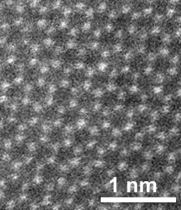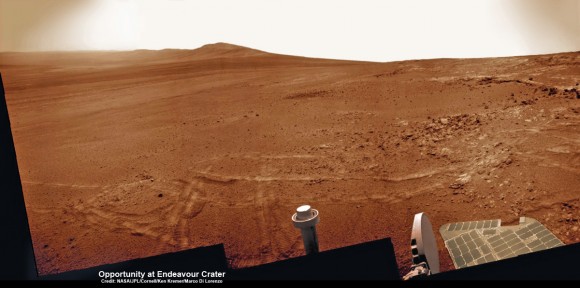
Electron-microscope atomic image of molybdenum sulfide monolayer film. Each of the dots indicates one Mo atom. (Credit: Dr. Linyou Cao/NC State University)
Researchers at North Carolina State University have developed a new technique for creating high-quality semiconductor thin films at the atomic scale — meaning the films are only one atom thick.
The technique can be used to create these thin films on a large scale, sufficient to coat wafers that are two inches wide, or larger.
“This could be used to scale current semiconductor technologies down to the atomic scale — lasers, light-emitting diodes (LEDs), computer chips, anything,” says Dr. Linyou Cao, an assistant professor of materials science and engineering at NC State and senior author of a paper on the work.
“People have been talking about this concept for a long time, but it wasn’t possible. With this discovery, I think it’s possible.”
Growing molybdenum sulfide in layers only one atom thick
The researchers worked with molybdenum sulfide (MoS2), an inexpensive semiconductor material with electronic and optical properties similar to materials already used in the semiconductor industry. However, MoS2 is different from other semiconductor materials because it can be “grown” in layers only one atom thick without compromising its properties.

Schematic illustration of the synthetic process, which includes five major steps:
sublimation, reaction, transfer, diffusion, and precipitation (credit: Dr. Linyou Cao/NC State University)
In the new technique, researchers place sulfur and molybdenum chloride powders in a furnace and gradually raise the temperature to 850 degrees Celsius, which vaporizes the powder. The two substances react at high temperatures to form MoS2. While still under high temperatures, the vapor is then deposited in a thin layer onto the substrate.
“The key to our success is the development of a new growth mechanism, a self-limiting growth,” Cao says. The researchers can precisely control the thickness of the MoS2 layer by controlling the partial pressure and vapor pressure in the furnace. Partial pressure is the tendency of atoms or molecules suspended in the air to condense into a solid and settle onto the substrate. Vapor pressure is the tendency of solid atoms or molecules on the substrate to vaporize and rise into the air.
“Using this technique, we can create wafer-scale MoS2 monolayer thin films, one atom thick, every time,” Cao says. “We can also produce layers that are two, three or four atoms thick.”
Cao’s team is now trying to find ways to create similar thin films in which each atomic layer is made of a different material. Cao is also working to create field-effect transistors and LEDs using the technique. Cao has filed a patent on the new technique.
The open access paper, “Controlled Scalable Synthesis of Uniform, High-Quality Monolayer and Few-layer MoS2 Films,” was published May 21 in Scientific Reports.
The research was funded by the U.S. Army Research Office.





















